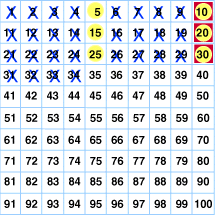Task
The task is to compare counting sequences on your calculator with the patterns they generate on the hundred board. Press the keys on the calculator to observe your counting sequence displayed on the hundred board. For example, press 5, +5, =, =, =, =, . . . Try the same process with other numbers. What patterns do you see? Can you predict what numbers will be marked?
Linking Visual and Numerical Patterns
Experiences with a variety of patterns help students recognize order and make predictions. Physical patterns, such as clap, clap, stomp, and repetitive actions in songs, such as "Hokey Pokey," appeal to the youngest learners. Creating patterns gives students opportunities to describe what is being repeated or how the pattern grows and to explain what should come next. Teachers often use colors and shapes to help highlight numerical patterns, such as the ones created by a first-grade class that marked every fifth and tenth day during the school year on a number line and a hundred board. (See what the class did below).
As students work with multiple representations of number and with counting, their knowledge of number concepts grows more sophisticated. When students place markers on hundred boards to highlight different counting sequences, they can see the relationships among the numbers and make connections between words and symbols. Linking numerical patterns to a visual display, as demonstrated in the interactive calculator and hundred board above is a way in which technology facilitates additional experiences, since students can view many different patterns in a brief time.
One Class’s Experience
As students have repeated experiences with patterns, they will be able to make and investigate conjectures about counting sequences. In preparation for celebrating the 100th day of school, a teacher had students complete hundred boards by coloring the patterns created by counting by fives, tens, and twos. She showed the students how to skip-count using a calculator so they could compare sequences on the calculator with those on the hundred board.
One pair of students began experimenting with counting by numbers other than twos, fives, and tens on their calculator. When they counted by threes, they noticed that they did not land on 100 on the display, as they did in counting by twos, fives and tens.
The teacher watched as the students removed the chips from their hundred board and started over with counting by threes. She also noticed that the students used the calculator to check the pattern. When the students repeated the work several times, she asked them to explain why they had repeated the process and what they were thinking. The students pointed out that 100 was not covered on the hundred board, as it had been in the other patterns they investigated, and they needed to check to see if they were placing the markers correctly. She encouraged them to make a permanent record of counting by threes on a hundred board and to see of they could figure out why 100 was not covered.
The teacher decided that it was important for the students to share what they were doing with the class. As a result of the class discussion, some students wondered if there were other patterns for which the markers would "go past" 100 without hitting it. This conjecture led to an investigation that continued the remainder of the year. Some students continued to use the hundred board for exploring patterns. Others enjoyed looking for patterns with the calculator, counting by twelves, fifteens, twenty-fives, and other numbers.
The students discovered that counting by fours gave 100 on the display. However, counting by sixes did not. Gradually, the students recognized that when they reached their first three-digit number, whether it was 100 or another number, their task was completed. They realized that 100 was more than ninety-something and was the smallest three-digit number.
Experiences such as these can support the development of intuitive notions about the meaning of factors and can reinforce place-value understandings.
Take Time to Reflect
- What role do counting sequences play in helping students understand number concepts?
- What naturally occurring classroom activities could serve as a context for teaching counting sequences?
- How do students' representations help them communicate their mathematical understandings?
- How can teachers use these various representations and the resulting conversations to assess students' understanding and plan worthwhile instructional tasks?
A First-Grade Class Works with Representations of Number and Counting
Students’ knowledge of number concepts and patterns grows more sophisticated as they work with different representations of number and counting. As part of the morning routine, one first-grade teacher had students represent numerical patterns in two ways. Each day they noted how many days of the school year had passed by writing the number on a strip of adding-machine tape. Every fifth day they made a circle around the number, and every tenth day they placed a square around the number. They discussed that the circles indicated counting by fives and the boxes showed counting by tens.

As another way of representing the same counting sequence, the students used a class hundred board and crossed out one number each day but highlighted every fifth day with yellow and every tenth day with red. As the days progressed, the students noticed that the highlighted numbers made a pattern of numbers ending in fives and zeros. The teacher used a calculator to show that the sequence of numbers that appeared in the display when counting by fives and by tens continued with the same pattern beyond 100.
